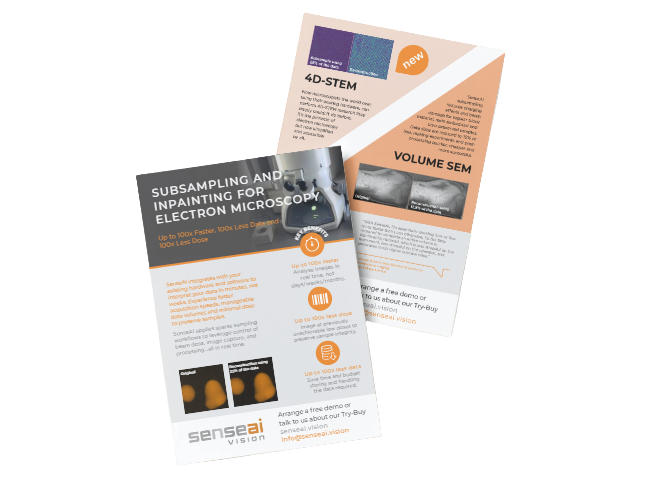Our product suite
Solutions that unlock computational imaging across a range of EM applications





suiteLow-dose, high speed methods tailored to your research and time demands
Many Electron Microscopy experiments have high failure rates, with inconclusive or inaccessible data. The vast imaging datasets create processing and storage bottlenecks, increasing costs
our product suiteOur range of products & applications

2D STEM
2D-STEM is a challenging technique which has many limitations including instability (i.e. drift), beam damage and slow frame rates.
With SenseAI, 2D-STEM can now be done live and therefore imaging areas of interest to save time in locating and analysing features. It uses less than 10% of the data.
Live 2D-STEM enables rich, atomic-resolution live analysis. It also reduces beam damage, so you can see what is actually happening without the destructive effect of the electron beam. Fundamentally it saves users time and now they can do and see new analyses they couldn’t do before, and simplifies it for all microscopists to be able to access.
It can help also with stability (from drift).

4D STEM
To date this has been one of the most challenging techniques, with historically low experimental success rates due to highly complex workflows. SenseAI’s 4D-STEM product democratises the technique by dramatically simplifying the workflow, from the alignment, acquisition and analytics.
Specific problems with both 2D-STEM and 4D-STEM are instability (i.e. drift), beam damage and slow frame rates as well as vast data sizes which makes post-processing problematic. Also a lack of pre-acquisition surveying in 4D-STEM creates limitations.
With SenseAI, 4D-STEM can now be done live and therefore imaging areas of interest to save time in locating and analysing features. It uses less than 10% of the data.
Live 4D-STEM (world-first) enables rich, atomic-resolution live analysis. It also reduces beam damage, so can see what is actually happening. Fundamentally it saves users time and now they can do and see new analyses they couldn’t do before, and simplifies it for all microscopists to be able to access.
Traditionally slow acquisition times means that only the most stable microscopes could consider using 4D STEM. Thanks to faster imaging via the use of subsampling, stability issues are minimised and high quality data are maintained.
Furthermore it can support live virtual detectors, live DPC, live centre of mass and post processing techniques such as ptychography.
It is the pinnacle of electron microscopy but now simplified.
Volume SEM
SenseAI can work with FIB-SEM and SBF (Serial Block Face)s for volumetric analyses across all sample types. The subsampling reduces charging effects and beam damage for regular block material samples, and both resin embedded and cryo preserved samples. It also dramatically speeds up workflows such that a sample that might take days to mill and image, would take a couple of hours. The data sizes are dramatically reduced too, 10% or less of the data required making the experiment and post-processing significantly quicker, easier and cheaper. It also reduces the amount of costs per image (and furthermore e.g. the FIB’s expensive gallium usage).
In summary, the images are better, quicker and lower cost.

SEM
SenseAI SEM supercharges all and any SEM. The subsampling reduces beam damage, improves stability, and speed by using 10% or less of the data.
This transforms your workflows and enables you to do more, better and quicker for less cost and resource.
It can also be used for volumetric analyses e.g. with microtomes as well as FIB and it speeds up both dramatically too. It is very simple to add to your existing microscopes and with any new ones too.
Whether you are doing Q&A or R&D, SenseAI makes your microscopy work better, quicker and lower-cost.

Denoise
SenseAI’s denoiser is simple to use and works across all techniques – 4D-STEM, 2D-STEM, TEM, and SEM. It can be used in post-processing (i.e. to denoise any images acquired by any other methods) or the entire workflows (i.e. for acquisition as well).
Customer Satisfaction
Achieved a 95% customer satisfaction rate across all AI solutions.
Cost Savings
Delivered over $10 million in cost savings for clients through optimized AI solutions.
how it worksNeural networks are a fundamental component of Artificial Intelligence (AI) systems
Neurons and Layers
Activation Function
Feedforward Process
Neurons and Layers
pricingSimple and flexible.
Only pay for what you use.
Working withNeuro has been a game-changer for our business. Their AI solutions have revolutionized our operations, enabling us to automate repetitive tasks and make data-driven decisions with ease. We couldn't be happier with the results."
Working withNeuro has been a game-changer for our business. Their AI solutions have revolutionized our operations, enabling us to automate repetitive tasks and make data-driven decisions with ease. We couldn't be happier with the results."
testimonialsHear what our customers say about our AI solutions
faqEverything you need
to know about SenseAI
At its core, SenseAI utilises an ultra-fast implementation of the beta process factor analysis (BPFA) algorithm. BPFA is used to learn a sparse representation of a dataset, which is then used to reconstruct that entire dataset. Unlike many other algorithms, BPFA is a blind inpainting algorithm, meaning that it can learn a dictionary from both fully sampled and subsampled data.
Subsampling is a core component of the SenseAI workflow, and involves the deliberate formation of incomplete datasets. By sampling a fraction of the data, such as only a handful of pixels within an image, subsampled data can be produced and processed using SenseAI. Subsampling can be achieved by manipulating scanning hardware, implementing novel detector designs, or operating in low signal conditions, and in almost all cases can aid in increasing the speed of data acquisition.
Subsampling can be applied to nearly every imaging platform, though the form it takes will depend on the system. In all cases, an incomplete dataset is formed – this means faster acquisition times and faster processing times. In scanning systems, the imaging flux can also be reduced, meaning that not only can information be acquired faster, but with less damage to sensitive materials.
Visit our Demo Centre
Choose from an on demand 3 minute demo or a more personal one-to-one walk-through.

Download our flyer
Download our flyer to share with your colleagues - superfast, low dose, low data imaging for Electron Microscopy.






